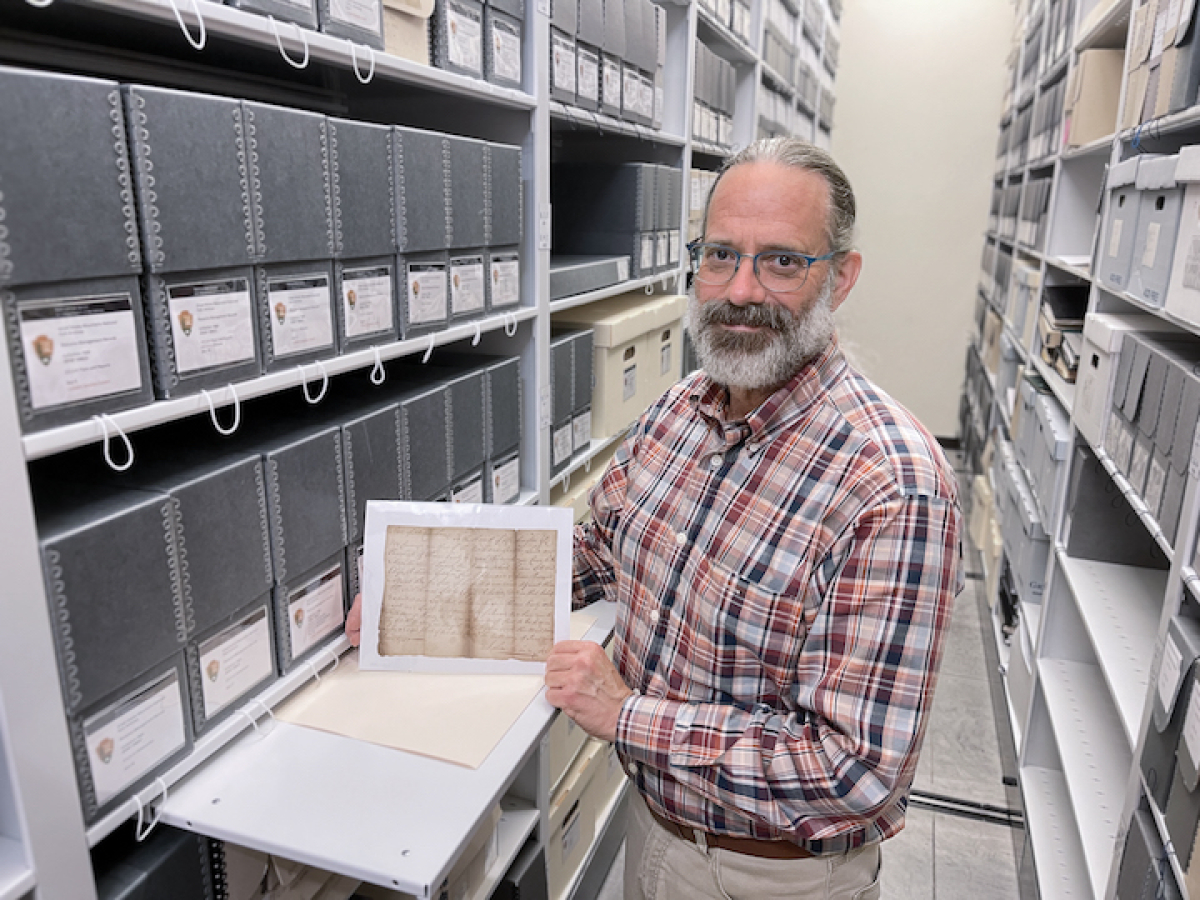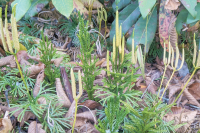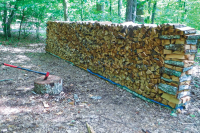Word from the Smokies: New book features letters from park archives
 Park librarian-archivist Michael Aday stands in the Great Smoky Mountains National Park archives holding a writ issued in 1786 by James Sevier — son of the governor of Franklin — which instructed the sheriff of Washington County to take Joseph Young into custody in relation to a case of assault and battery brought by Alexander Donny. GSMA photo
Park librarian-archivist Michael Aday stands in the Great Smoky Mountains National Park archives holding a writ issued in 1786 by James Sevier — son of the governor of Franklin — which instructed the sheriff of Washington County to take Joseph Young into custody in relation to a case of assault and battery brought by Alexander Donny. GSMA photo
Most people come to the Great Smoky Mountains National Park for its scenic vistas, waterfalls and wildlife — seeking an escape to the great outdoors.
But there are also wonders to discover indoors when you visit the Collections Preservation Center on the peaceful side of the Smokies in Townsend, Tennessee. Here, unbeknownst to many a park visitor, lie the park’s vast archives—1.4 million historic records that would reach roughly 1,130 linear feet if you laid their boxes together end to end. That’s taller than the Eiffel Tower.
This colossal cache of documents would be beyond the reach of most people were it not for the park’s archivist and librarian Michael Aday, who fields an average of 350 research requests each year. His new book, “Letters from the Smokies,” presents 19 thoughtfully curated correspondences written over the span of 230 years. Each letter, shown along with supporting images, is the centerpiece of a strikingly designed chapter providing historical context and interpretation of the document.
“I feel like there’s something for everyone in this book,” said Aday, who has a master’s degree in history and archival administration from the University of Texas. “I think the first-time visitor to the Smokies who wants to know more about the history of the park and the region will find some great stories to engage them, while the seasoned visitor will hopefully learn some things they didn’t know before.”
Aday worked at the Dallas Municipal Archives, the Dallas Museum of Art and the Old Red Museum of Dallas County History and Culture before landing in the Smokies in 2013. But his love of artifacts dates back to a very specific event that coincided with the observances marking the bicentennial of the United States.
“In 1976, when I was 10 years old, the American Freedom Train stopped in Dallas, Texas, and changed my life,” he said. “The American Freedom Train was an exhibition of American history taken from the collections of the Smithsonian Institute, the National Archives and other museums. There were 26 train cars displaying 500 historic artifacts, pulled across the country by steam locomotive — things like Judy Garland’s ruby slippers from ‘The Wizard of Oz,’ a moon rock, Abraham Lincoln’s preliminary draft of the Emancipation Proclamation and George Washington’s personal copy of the Constitution. These may have been the first historic documents I ever saw and certainly remain the most important I’ve ever seen.”
Related Items
This varied assortment seems to have inspired Aday in his curation of the new book, which includes characters ranging from a furtive Tennessee woman writing about Southern life under a male pseudonym to the celebrated ornithologist Roger Tory Peterson undertaking an epic road trip that included the Smokies. Readers will learn how an artificial lake would have engulfed the park’s beloved Cades Cove and hear the remarkable tale of a Smokies bobcat gifted to a U.S. president. An 1879 tax license issued to “retailer of spirits” Deborah McGee tells the story of a beloved fixture in a remote community who made space for herself in arenas often dominated by men. A telegram to Anne Davis congratulates her on the passage of a bill authorizing the purchase of 78,000 acres of land for a new national park she helped make possible. Another preserved letter spotlights Jewell Manor’s grief at the untimely death of her cousin Charley, a Civilian Conservation Corps worker in the national park.
Aday describes himself as being a voracious reader as a child. The first book he remembers having a real impact on him was “Escape from Warsaw” by Ian Serraillier.
“I was almost beside myself when I would see the library bookmobile in the neighborhood grocery store parking lot,” he recalled. “I would grab my canvas knapsack and my bicycle and race off like all the good books would be gone before I got there. I read books about vampires, inventors, world history, science fiction and almost anything else the librarian recommended.”
Yearning to be a writer for as far back as he can recall, Aday has penned a plethora of articles and papers throughout his career, but this is the first time he’s authored a book.
“Someone once told me that writing is rewriting, and truer words were never spoken,” he said. “The research, writing and revisions were incredibly important and kept me up nights with worry.”
Aday’s goal was for the book to touch on points of view that have been left out of most stories about the Smokies — primarily those of African Americans, indigenous people and women.
“The easy part was deciding on the topics I wanted to cover and breadth of the stories I wanted to tell,” he said. “The hard part was finding some of the documents that I would need to tell these stories. Once those documents were identified, the task of researching their origins and authors and putting them into a greater context became my next difficult task.”
He began writing the book in the first month of the COVID-19 pandemic when the entire country shut down. This made research extremely difficult and delayed the writing process. He credits his wife, Denise, with providing the support he needed to persevere.
“Denise worked with me on structure, composition, tone and language,” he said. “She helped me ensure that the language was inclusive and as bias-free as possible. She was also my most ardent cheerleader and was integral to the development of each chapter.”
While “Letters from the Smokies” focuses on historical correspondence, the archive itself contains much more than letters. Among its treasures are more than 35,000 historic photographs providing a visual history of the region and over 3,500 hours of recorded and transcribed oral histories, plus the park’s own museum artifact collection.
“It’s important that archivists engage with the public about the work they do and the collections they manage,” Aday said. “In a federal archive, we have a legal responsibility to preserve and maintain records for the American public, but if the public doesn’t know these records exist, are we really doing enough? We must educate the public about what archives are and how to access the information they hold. This book is a great tool in that education process.”
“Letters from the Smokies,” a 6-by-9-inch softcover work of nonfiction in full color, is available for $16.99 in the park’s visitor center bookstores and at the Great Smoky Mountains National Park’s online store at SmokiesInformation.org.
The Collections Preservation Center is a result of the partnership between GSMA, Friends of the Smokies, the Great Smoky Mountains Heritage Center, and the National Park Service. The archives are accessible to anyone who has an interest in the history of the park or the region. Contact Aday at 865.448.2247 or This email address is being protected from spambots. You need JavaScript enabled to view it. to discuss your research needs and schedule an appointment.
Frances Figart (rhymes with “tiger”) is the editor of “Smokies Life” and the Creative Services Director for the 29,000-member Great Smoky Mountains Association, an educational nonprofit partner of Great Smoky Mountains National Park. Reach her at This email address is being protected from spambots. You need JavaScript enabled to view it..













